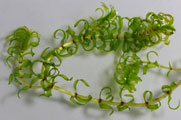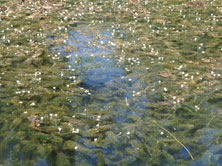
Source: Elodea Nuttallii 2, Christian Fischer, Wikipedia Commons
In order to see energy conversions in the cell in action, complete this online lab. In this lab, you will use an indicator called bromothymol blue. Bromothymol blue (BTB) is a blue-green liquid which changes to a yellow color when exposed to an acid. When carbon dioxide is placed in water, it produces carbonic acid.

Source: Elodea Nuttallii 2, Christian Fischer, Wikipedia Commons
Elodea is a small, freshwater plant that is commonly called waterweed. It is often used in aquariums.

Source: Leafy Elodea, NSW Department of Primary Industries
Elodea is found growing completely submerged in shallow water where sunlight can reach the bottom. Only the flowers of elodea reach the surface. The white spots in this picture are the flowers of the elodea plant.
![]() Click on the Begin button to start the animation.
Click on the Begin button to start the animation.
Answer the following questions about the lab on a piece of paper.
Interactive popup. Assistance may be required.
The purpose of beaker A was that it was the control group.
Interactive popup. Assistance may be required.
The constants in this lab were the following:
Interactive popup. Assistance may be required.
The solution turned yellow because BTB was exposed to acid. When carbon dioxide sits in water, it produces carbonic acid. When fish undergo respiration, they produce carbon dioxide. Therefore, the carbonic acid was produced and the solution changed colors.
Interactive popup. Assistance may be required.
During respiration, plants take in oxygen and produce carbon dioxide. Because of this, you may have thought the solution would turn yellow. However, during the process of photosynthesis, plants take in carbon dioxide and release oxygen. This process happens when plants take in sunlight. When the elodea was added to the solution and put in the light, the elodea absorbed the carbon dioxide it produced during respiration and the solution stayed blue-green. In the dark, the elodea did not absorb the carbon dioxide; it produced during respiration, so the solution turned yellow.
Interactive popup. Assistance may be required.
The fish and the elodea produced carbon dioxide during respiration. In the light, the elodea absorbed the carbon dioxide produced during the process of respiration; therefore, the BTB was a pale blue. In the dark, the elodea cannot absorb the carbon dioxide so the BTB solution turned yellow.